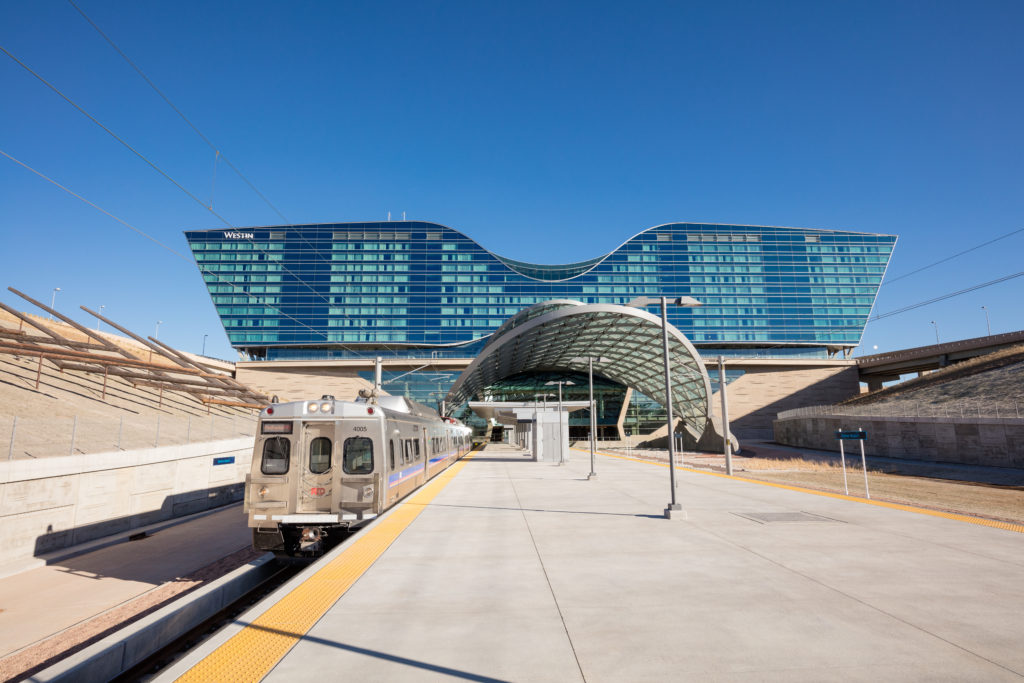
For better or worse, cars are part of the social fabric of business. They can cue status through a coveted parking spot or fleet vehicle. They can raise anxiety levels of drivers who sit in gridlocked traffic.
But there is a revolution coming – and it’s changing how cars are woven into that fabric of business – thanks to a deluge of data we carry in our smartphones, the growing development of autonomous vehicles and a region that is increasingly connected by trains, bike lanes and buses.
“(The car) changed everything about how we build, how we interact. … Now we’re looking at another change that will move us in a very different direction,” said Stuart Anderson, executive director of the central Denver-focused transportation management association Transportation Solutions.
And, with a population the size of Oklahoma City estimated to settle in the region over the next 25 years, transportation planners have the difficult task of envisioning that future – and adjusting it as we grow and technology changes.
Since we first envisioned a project like Central 70 in the early 2000s, the first iPhone came out in 2007, Waze launched its crowdsourced map app in 2008 and Uber debuted in Denver in 2012.
And while pivoting to work with this new technology is challenging, it’s also creating opportunities, said Colorado Department of Transportation (CDOT) Executive Director Shailen Bhatt. Those opportunities are bringing together planners and the private sector – and they’re working to find innovative solutions to congestion and safety on commutes.
“That’s how we’re going to start making smart decisions with scarce resources,” he said.
Cars, Roads Get Smart
With connections through smartphones and increasingly smart cars with sensors and software, we’re leaving a roadmap of data that shows how traffic is moving and what the road conditions are like. How that information is shared can change how quickly and safely we travel.
Over the next year, CDOT is partnering with Germany-based mapping and location tech company HERE on pilots along I-25 and the I-70 mountain corridor through CDOT’s RoadX program.

The partnership is marking firsts in the U.S. and North America for the rollout of this technology, which will share data with other cars to help drivers adjust and move them more efficiently.
RoadX is an example of a great private sector idea, and Bhatt said he wants people to bring those ideas to CDOT.
“We’re committed to deploying great ideas very quickly,” he said.
It’s a conversation happening nationally, too, which is why the U.S. Department of Transportation is offering up to $40 million to cities that propose new ways to be “smart” by incorporating innovative technology into its transportation system.
Denver is among the seven finalists vying for the Smart City Challenge Grant, and the Chamber is among the dozens of organizations working on the plan. The winner will be announced in June.
Denver’s goal is simple: connect more with less. The 50-plus partners will do that by working together to:
- Integrate all transportation options—from RTD to the city’s bike, car and ride sharing companies with the GoDenver mobile app.
- Increase the number of electrified vehicles—particularly among taxis, city fleets and ride share options.
- Use tools like RoadX to introduce more connected vehicle technology in anticipation of autonomous vehicles.
With a track-record of investing in its infrastructure through projects like FasTracks and using innovative public-private partnerships to get that work done, planners say Denver makes a strong case.
“Whatever city is the selected city will be a lab,” said Denver Deputy Chief of Staff Evan Dreyer.
First and Last Miles Matter Most
In April, Denver joined an elite group of cities that have a rail connection to the airport. Meanwhile, around the transit hub of Denver Union Station investment has just passed $2 billion.
In 2016, RTD will open five commuter rail lines. “We’re more than doubling our rail in the region,” said RTD Senior Public Relations Manager Nate Currey. “No other transit agency in history has ever tried anything like this.”
While transportation experts laud the vision of the FasTracks commuter corridor that connects the region, they agree that they have to develop a habit among commuters now and find ways to integrate the companies that are changing transportation so that they can work together, not against each other.
That’s because convenience will always be key for commuters. And getting to and from stations to work or home—what transportation experts call the first and last mile, can be the “Achilles’ heel of transit,” said Daniel Hutton, manager of Centennial’s i-team (short for innovation).

The i-team has been developing a pilot model to help commuters get to and from light rail stations using rideshare platforms. Working with Mobility Choice, a nonprofit of the Chamber, along with several other project partners, a commuter would be able to plan his trip, from seeing when he needs to be at the station to hailing a rideshare driver.
Ease is paramount: “Then you really only have one decision point,” Hutton said.
For car share companies like Car2Go, that specialize in short trips, Denver General Manager Mike Pletsch said that at least 1,000 trips made each month by its 37,000 Colorado members are made to transit stations. Car2Go’s white and blue Smart cars move as much as 19 times a day in the downtown core.
“It’s not competition; it’s a compliment,” Pletsch said. “Folks just want options.”
New Partnerships Emerge
With a flat gas tax, uncertainty of state funding and a population that is continuing to grow faster than the rest of the country, it’s clear that when it comes to figuring out how Coloradans will get to work today and in the future, two heads is better than one.
And, from public-private partnerships to convening local agencies, these collaborations are growing. The Chamber’s Mobility Choice is working to bring together CDOT, RTD and the Denver Regional Council of Governments with the private sector. Helmed by former CDOT director Don Hunt, the goal is to help shape a single mobility plan for the region.
It’s challenging to balance the needs of a diverse metro area, said Doug Rex, DRCOG’s transportation planning and operations director, so giving people options, especially as the region grows, matters.
“What we are trying to do here is diversify our transportation portfolio,” he said. “We are providing our trcitizens an option of transportation modes.”
But, the economics of a driverless future are too strong to sit back, Hunt said.
“That is the big change agent that will really dominate how we travel in the future.”

Sara Crocker is the communications manager for the Denver Metro Chamber of Commerce.
This was originally published in the Spring Issue of Business Altitude. Click here to read the full issue.
